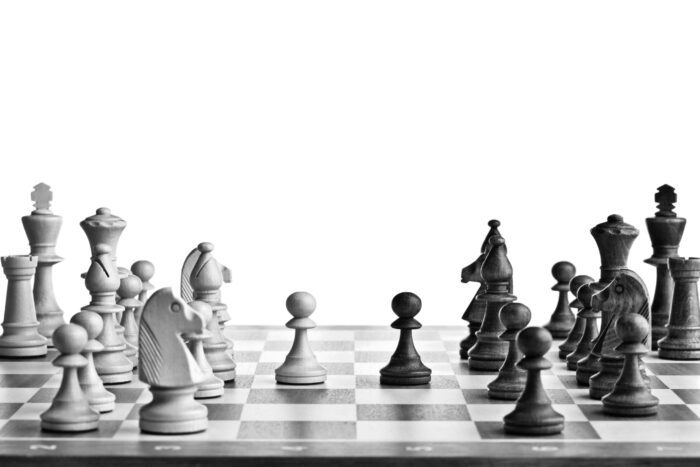For all of us in business, we’re rapidly approaching the dreaded “business plan” season. During my time at The Coca-Cola Company, we spent almost all of October and November crafting massive business plans, complete with extensive presentation decks tailored for senior management.
Even if your company (hopefully) doesn’t dedicate quite as much time to crafting inflexible and overly complex business plans, the truth remains that nearly every company has a business plan process.

We can engage in tabletop and wargame exercises as we prepare for the business plan process. A business war game is an innovative strategic simulation tool that helps organizations assess various scenarios and their impacts on business decisions. These exercises are dynamic tools for exploring ideas, providing invaluable insights before these concepts enter the formal business plan. Wargame exercises also serve as practical training, helping teams develop and refine their strategic thinking in a controlled environment.
Understanding the Dynamics of Wargame Exercises
A business wargaming exercise is a captivating and illuminating strategic simulation that deftly fuses creativity with practicality, emphasizing its role in strategic planning and decision-making.
Its origins can be traced back to military exercises designed to prepare forces for real combat scenarios. In these exercises, military units practice tactics and strategies in controlled environments, allowing them to anticipate and respond to real-world challenges. Over time, this concept has gracefully evolved, transcending its military roots to become a versatile tool applicable across various industries.
In business, a wargame exercise is akin to orchestrating a grand symphony of strategy, innovation, and anticipation. It systematically explores what-ifs and what-may-be, providing an invaluable opportunity to navigate the intricate labyrinth of decision-making.
At its core, a wargame exercise bridges the theoretical and the pragmatic, a space where ideas are tested, hypotheses are examined, and strategies are honed.
How Does a Wargame Exercise Work?
This dynamic exercise unfolds by simulating intricate and multifaceted scenarios, much like a chessboard where every piece represents a variable in the business landscape.
Like skilled chess players, participants embody various organizational roles, including home teams and competitor teams. These roles might encompass a spectrum from top-level executives to operational managers, each responsible for different facets of the enterprise’s functioning. Participants are divided into two teams representing different operational planning sides, tasked with developing and dynamically adjusting strategies as they interact within a simulated information environment.
This role-playing isn’t merely an academic exercise – it’s a voyage into the heart of strategy, where participants must think, decide, and act within the boundaries of their designated roles.
What Makes a Wargame Exercise Unique?
What sets a wargame exercise apart is its emphasis on anticipatory thinking. Much like a chess master visualizes several moves ahead, participants must navigate the competitive environment and simulate combat-like scenarios to predict the consequences of their actions.

It’s an artful blend of creative brainstorming and pragmatic foresight, demanding a deep understanding of the organization’s dynamics, market trends, competitor behaviors, and industry regulations.
As the exercise progresses through its simulated rounds, decisions made by participants cascade and interweave, emulating the intricate interplay of real-world choices. The result is an unfolding narrative of strategic moves and countermoves akin to the pages of a riveting business novel.
However, unlike a novel, this narrative is influenced by the participants’ collective intelligence, knowledge, and insights.
What is the Objective of a Wargame?
A wargame exercise aims to emerge with theoretical strategies and battle-tested approaches. It’s a forge where the raw material of ideas is shaped, tempered, and refined into actionable plans. These exercises are crucial for military planning, as they test and refine strategies, helping officers prepare for real-world challenges.
By immersing themselves in these simulations, participants develop an acute sense of how strategies interact, where opportunities are hidden, and how to gain a competitive advantage. This immersive experience nurtures adaptability, critical thinking, collaboration, and a deep appreciation for the complexities of the business ecosystem.
A wargame exercise is more than a simulation; it’s a journey. A journey that propels participants beyond the boundaries of their comfort zones, urging them to think beyond the obvious, challenge assumptions, and embrace the uncertainty that often accompanies strategic decision-making.

As businesses continue to evolve and navigate a dynamic landscape, the wargame exercise remains an invaluable compass, guiding leaders and teams towards strategies that aren’t just visionary on paper but resilient and robust in practice.
So, as the winds of business planning season draw near, consider embarking on this transformative journey. This journey starts with the subtle shuffle of chess pieces on the board but evolves into a symphony of strategic brilliance. It’s wargame season, a time to explore, innovate, and prepare for challenges and opportunities.
Distinguishing Wargame and Tabletop Exercises
While both wargame and tabletop exercises stand united by the grand purpose of strategy testing, a closer examination reveals distinctions that offer unique insights into organizational dynamics and readiness.
Tabletop exercises focus on using response strategies in emergency scenarios, ensuring that participants engage in practical applications of their training.
Tabletop Exercises: Precision in Preparedness
Imagine a scenario where the unexpected strikes – perhaps a terrorist attack, a cyberattack, a natural disaster, or a supply chain disruption. This is where tabletop exercises come into play.
These exercises are precision instruments designed to hone an organization’s preparedness for various emergency scenarios. They are finely crafted instruments that orchestrate focused drills, allowing teams to assess their response strategies methodically.
Tabletop exercises are like spotlight examinations. Their concentration lies in dissecting specific challenges and testing the efficiency of pre-established emergency plans. Participants, often critical stakeholders from various departments, gather around a symbolic table (or, these days, a virtual one) to discuss, debate, and strategize their responses to the given scenario.
Similar, but Different
While tabletop exercises are like targeted rehearsals for specific scenarios, war games resemble a grand symphony where strategies harmonize, diverge, and intertwine. They simulate military operations to refine strategic approaches, preparing forces for combat and analyzing potential wartime decisions. One sharpens the crisis response toolkit, while the other refine the strategic compass.
As businesses navigate an ever-evolving landscape, the ability to wield precision and panoramic approaches can determine their survival and triumph.
So, whether you’re perfecting your organization’s preparedness for the unexpected or orchestrating a symphony of strategies, remember that each exercise plays a pivotal role in steering your ship through the intricate waters of the business world.
As business planning season approaches, consider the spectrum of exercises available to you, recognizing the unique values each brings. It’s a season of exploration, introspection, and strategic evolution, where wargames and tabletops align to empower your journey.
Strategic Preparations Elevated: Harnessing the Power of Business Wargaming
In the intricate dance of business strategy, where every decision carries weight and every move sets the stage for the future, the concept of a “safe space” takes on new significance. Enter the wargame exercises – a strategic tool and controlled crucible where strategies are forged, tested, and honed, all before they step onto the grand stage of business reality.
These exercises prepare organizations for future wars by simulating potential scenarios, ensuring they are ready for the unpredictability and complexities of upcoming conflicts.
A Laboratory for Strategy Experimentation
At its heart, the beauty of wargame exercises lies in their role as sophisticated laboratories for strategy experimentation. Unlike military exercises that involve actual military forces to ensure combat readiness, business wargames, like military wargames, do not involve actual military forces but simulate scenarios to test strategies and tactics. By incorporating insights from market research, these exercises enhance the effectiveness of business wargaming, allowing participants to interact with market dynamics and understand real-world market behaviors actively.
By engaging in these simulations before the frenzied whirlwind of the business planning process, companies set the stage for profound insights, innovation, and adaptive resilience.
Testing Strategies in a Controlled Environment
Consider wargame exercises as a training ground for your strategic ambitions. Just as actors rehearse their lines and choreography before opening night, organizations can rehearse their strategies within the forgiving walls of a simulated environment, enhancing team building and collaboration among participants.
Here, the stakes are lower, the risks are contained, and the consequences are confined to the realm of imagination. It’s a space where ideas can be unleashed, questioned, tweaked, and refined without fearing real-world repercussions.
Harmonizing a Symphony of Perspectives
This rehearsal extends beyond the individual players; it encompasses the collective genius of the entire team. As participants from various departments and levels of the organization immerse themselves in the wargame exercise, understanding the structure and operations of military services is essential for effective training. The market team simulates market reactions and awards market share to competing teams based on their strategic moves, creating a symphony of perspectives.

Finance insights harmonize with market insights, and operational realities interlace marketing strategies. The result? A holistic exploration that mirrors the true complexity of real-world decision-making.
Navigating a Distinct Vantage Point
Organizations gain a distinct vantage point as the scenarios unfold within the simulated landscape. The naval war college, renowned for developing strategies and methodologies for professional wargaming, exemplifies how access to competitive intelligence is crucial for gaining insights about markets and competitors, allowing potential pitfalls to emerge, like hidden landmines waiting to be defused through strategic adjustments.
Pivot points become evident, offering the chance to reroute strategies before they navigate the convoluted path of the business arena. Yet, it’s not just about averting disasters; it’s about spotting the sparkling gems of opportunities that might otherwise be obscured in the tumult of daily operations.
Cultivating a Culture of Innovation
This incubation of strategies within wargame exercises cultivates an environment where innovation thrives. According to scholarly articles in the Naval War College Review, these exercises analyze the effectiveness of wargaming in enhancing military strategy development and education. It’s akin to the fertile soil of a garden where ideas take root, nurtured by the collaboration and creative sparks that the exercise fosters.
These exercises enhance strategic thinking and improve decision-making processes within organizations. Unburdened by the pressures of immediate execution, teams can explore bold ideas, challenge conventions, and imagine scenarios that might seem audacious under regular circumstances.
Galvanizing Collaboration and Cross-Functional Understanding
Moreover, wargame exercises galvanize collaboration. Participants learn to navigate the delicate art of alignment and compromise, a skill that serves them well when the real-world stakes are high. With few exceptions, wargaming literature tends to avoid fundamental epistemological questions, but these business war games, as strategic simulations conducted within organizations, foster a culture where cross-functional understanding is cultivated, communication flows seamlessly, and silos crumble under the weight of collective endeavor.
Embrace the Transformative Potential
So, as the business planning season approaches, consider the transformative potential of wargame exercises. Conducting a successful war game for training can significantly enhance leadership development and decision-making skills, providing a platform to explore ideas and strategies before the grand performance.

It’s a sanctuary where innovation is nurtured, collaboration is celebrated, and visions are refined. As you embark on this journey, remember that in business strategy, the most outstanding performances are often born from meticulous rehearsals, from the intricate choreography of wargame exercises that enable you to shine brightly on the stage of success.
Striking Harmony in Business Strategy: Balancing Offensive and Defensive Maneuvers
Within the dynamic theater of the business landscape, the strategy concept is akin to orchestrating a symphony – a harmonious blend of melodies encompassing both the bold crescendos of offense and the protective undertones of defense.
Just as a skilled composer interweaves various instruments to create a masterpiece, successful businesses harmonize offensive and defensive strategies to navigate the ebb and flow of uncertainty. Wargame exercises are crucial in military planning because they test and refine strategies, ensuring preparedness for real-world challenges. Traditional strategic planning often falls short in such dynamic and unpredictable environments, relying on static assumptions that fail to account for unexpected changes.
Picture the strategic battlefield as a chessboard, where every move carries consequences. Here, the distinction between offense and defense becomes pivotal.
While the allure of offense lies in the thrill of conquest and innovation, defense offers the assurance of resilience and preparedness. It’s a delicate balancing act that distinguishes thriving organizations from the rest.
Embracing the Dual Nature of Strategy
In the grand tapestry of business, offensive and defensive strategies represent two sides of the same coin, each essential for holistic success.
Offensive strategies are the torchbearers of innovation and progress. Like knights charging across the board, they seek new avenues, explore uncharted territories, and capitalize on opportunities others might overlook. War gaming can be crucial, allowing businesses to forecast demand and test product launches through role-playing exercises that simulate market conditions and refine strategic approaches akin to military operations.
But just as a knight’s charge requires a fortified castle to retreat to, offensive strategies must be complemented by defensive fortifications. Defensive schemes, like the vigilant rooks guarding the corners, anticipate and brace against potential challenges.
These strategies are the sentinels of stability and resilience, shielding organizations from the unexpected storms that can brew in the business landscape. They encompass risk management, scenario planning, and the preparation needed to navigate disruptions while minimizing negative impact.
Creating Strategic Harmony
In the symphony of business strategy, the true magic lies in orchestrating these two forces – offense and defense – in seamless harmony.
Consider a scenario where an organization embarks on an ambitious market expansion (offense) while concurrently bolstering cybersecurity measures (defense). Utilizing a business war game as an innovative strategic simulation tool can facilitate this dual approach, helping organizations assess various scenarios and their impacts on business decisions. This ensures that growth doesn’t come at the cost of vulnerability. These wargame exercises focus on using strategies in real-world scenarios, providing a practical framework for decision-making.

This strategic duality is particularly pertinent in the face of uncertainty. As a master chess player plans attacking and defensive moves, businesses must anticipate various possibilities. While offense fuels innovation and growth, defense provides a safety net, assuring stakeholders that the organization can navigate challenges without compromising its trajectory.
Leveraging Wargame Exercises and Competitive Intelligence to Fine-Tune the Balance
Wargame exercises shine as invaluable tools in striking this strategic harmony. These exercises simulate scenarios encompassing offensive and defensive elements, providing a fertile ground to explore how these strategies interact and influence each other. War games, in particular, are beneficial for strategy planning, role-playing different competitive scenarios, and pressure-testing business strategies, offering a dynamic and interactive approach compared to traditional methods like market research.
Wargame exercises also prepare organizations for future wars by simulating potential scenarios, helping them adapt to the unpredictability and complexities of upcoming conflicts.
The simulation is a laboratory where leaders and teams can witness the dynamic dance between bold exploration and prudent preparedness.
As wargame exercises unfold, participants encounter scenarios demanding offensive and defensive decision-making.
They witness firsthand the delicate equilibrium required to seize opportunities while guarding against potential setbacks. Organizations refine their strategies by engaging in these exercises and cultivating a nuanced understanding of the interconnectedness between offense and defense.
As the curtains rise on the business planning season, remember that a successful performance demands the harmonious convergence of offensive and defensive strategies. Just as a symphony needs both soaring crescendos and subtle refrains, businesses thrive when they embrace innovation and resilience in equal measure.
So, embrace the power of strategic harmony, let wargame exercises guide you, and compose a symphony of success that resonates across the ever-evolving business landscape.
Frequently Asked Questions About Business Wargames
What is a business wargame, and why is it important?
A business wargame is a strategic simulation exercise where a company tests its business plan by simulating real-world challenges, competitors’ actions, and market dynamics. It’s important because it serves as a training ground for strategic decision-making, allowing businesses to anticipate potential obstacles, refine strategies, and gain a competitive edge by preparing for various scenarios before they occur in the real world.
How often should a company conduct a business wargame?
The frequency of conducting business wargames depends on the industry and the pace of change in the market. However, running a wargame is generally recommended whenever a significant change in the business environment, such as a new product launch, market entry, or during annual strategic planning sessions.
Can small businesses benefit from wargames, or are they only for large corporations?
Small businesses can benefit from wargames. While the scale might be smaller, the insights gained can be just as valuable. Wargaming helps small businesses anticipate challenges, make more informed decisions, and better allocate limited resources to maximize their impact.
What are some critical components of an effective business wargame?
An effective business wargame includes a clear objective, realistic scenarios, a diverse team representing different perspectives, competitive intelligence, and a structured debriefing session to analyze outcomes and refine strategies. The goal is to create a realistic and challenging environment that forces the team to think critically and adapt their strategy.
Your Wargame Journey with Asymmetric
Are you ready to revolutionize your strategic planning process with a business wargame? Look no further than Asymmetric.

Are you ready to revolutionize your strategic planning process with a business wargame? Look no further than Asymmetric.
Our specialized two-day wargame and tabletop exercise sessions are tailored to accommodate a group of six to nine participants from your company for practical training purposes in strategic decision-making.
During these intensive days, we explore up to three pivotal ideas or concepts that could redefine your business strategies. Our skilled facilitators guide you through each scenario, fostering collaboration, innovation, and a holistic understanding of the challenges and opportunities ahead.
Contact Us Today
Ready to take your business planning to the next level? Incorporate wargaming into your strategic process with expert guidance from Asymmetric Marketing. Our wargame sessions serve practical training purposes in strategic decision-making.
Contact Us: Need help setting up a business wargame or refining your business strategy? Contact Us Today
Let’s Strategize Together: Equip your business with the tools and insights to navigate uncertainty and outmaneuver competitors. Start your journey toward a more robust business strategy today.
About the author
Mark A. Hope is the co-founder and Partner at Asymmetric Marketing, an innovative agency dedicated to creating high-performance sales and marketing systems, campaigns, processes, and strategies tailored for small businesses. With extensive experience spanning various industries, Asymmetric Marketing excels in delivering customized solutions that drive growth and success. If you’re looking to implement the strategies discussed in this article or need expert guidance on enhancing your marketing efforts, Mark is here to help. Contact him at 608-410-4450 or via email at mark.hope@asymmetric.pro.


